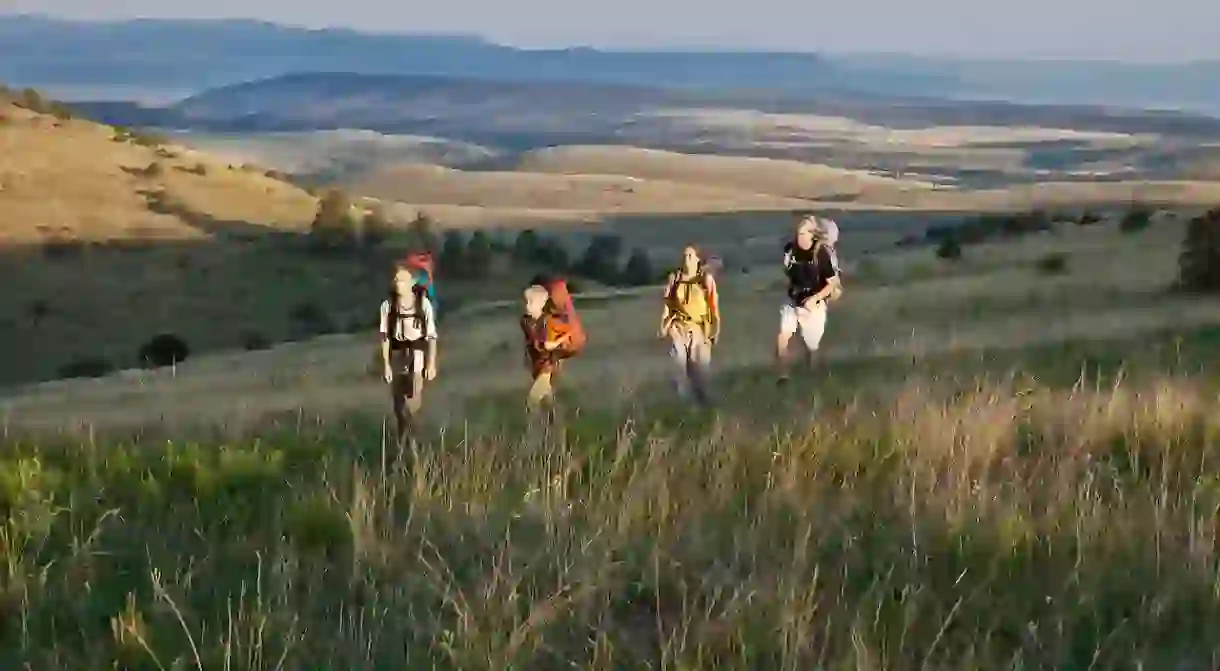The Best USA Hikes: Continental Divide Trail

When it comes to America’s long-distance hiking trails, there is no higher, more difficult, or more remote scenic trail than the Continental Divide Trail. Dubbed the ‘King of Trails,’ the CDT spans 3,100 miles from Canada to the Mexican border, revealing the immense diversity of the nation’s landscapes and ecosystems as it traverses through five states – from tundra and high glacial valleys to desert mountains. Led by a non-profit coalition, the CDT was officially designated in 1978, and it is still preserved today as one of America’s greatest living museums with nearly two thousand historical, natural and cultural treasures, and abundant wildlife. Every year, 150 ambitious hikers attempt to hike the CDT in its entirety, but only a handful are successful. For tips on how to best prepare, read on.
Important Info
The Continental Divide Trail isn’t just for the well-versed hiker – plenty of inexperienced mountaineers head to the CDT for single day hikes, multi-day hikes, or section hiking. Plus, the finished parts of the trail play host to an array of outdoorsy activities such as hiking, fishing, and cross-country skiing. Because the CDT is a strenuous and challenging hike, it’s essential to prepare for extreme conditions – it can snow any time of the year on the CDT, especially in New Mexico – be equipped for emergencies, and sharpen your physical and mental vigor before heading out. The CDT, traveling through varying landscapes, should not be tackled without a map and a compass; there are many roadless sections, and a compass can help you find your way in both unfamiliar terrain and during inclement weather. Thru-hikers should also come up with a solid plan regarding water, and understand how to find and treat water along the way (water can be scarce along the CDT, especially in Wyoming’s Great Divide Basin and New Mexico). Should you encounter bad weather, bring enough food in case of a change of plans, and know where to resupply via mail drop. Extra clothes are also key in staying warm, and preventing sickness or hypothermia.
Experienced mountaineers always stress the importance of equipment on long-distance hiking trails, and this is especially important on the CDT – be sure you have a rain cover for both your pack and tent, bear-resistant storage containers, a first-aid kit, sunscreen, polarized sunglasses, a pocket knife, a flashlight, a repair kit, and proper footwear. Other tips include bringing matches and firestarter (inside of a waterproof container), giving your finalized itinerary to a close friend or family member in case of emergency, signing in at trailheads (to track your location), and stay alert. There are many risks and challenges along the CDT, so adventurers should take into account the likelihood of altitude sickness, lightning and hail, heat exhaustion or heat stroke, and avalanches. As for permits, these are only required in the national parks; find out where you’re headed first before applying. Not sure if the CDT is open? Check here for closures and notices along the trail.

What To See
The CDT is home to many diverse landscapes, from the deserts of New Mexico to the Great Divide Basin of Wyoming. While in New Mexico, don’t miss the beautiful landscapes of San Pedro Parks and Chama River Wilderness – a striking natural landscape filled with canyons, mountains, and mesas. Other must-sees include the Rio Puerco wildlands, the El Malpais National Monument badlands – a scenic volcanic landscape – and the Big Hatchet Mountains Wilderness Study Area, a historic region that used to be occupied by a tribe of Chiricahua Apache natives.
In Colorado, the CDT reveals the beauty of the Rocky Mountains with over 1,000 summits that rise over 10,000 feet in the air. While traveling through the mountainside at 11,000 feet, take in the remarkable views of the South San Juan and La Garita Wildernesses, and don’t miss the half-million acre Weminuche Wilderness with views of glacial valleys and the Needle Mountains. For the history buffs, stop into the late-1800s ghost town, Hancock. For more stunning natural wonders, revel in the beauty of the Collegiate Peaks, the geological formations (The Window, Knife Edge, and Devil’s Thumb), and the massive Grays Peak – the highest point on the CDT at 14,270 feet. Other noteworthy sights include the Never Summer Wilderness and glacial lakes of the Mount Zirkel Wilderness.

Wyoming boasts many hidden treasures along the CDT, including the Wild Ponies, Wind River Range – with thousands of lakes and some of the largest glaciers in the US mainland – The Great Divide Basin, the famed Yellowstone National Park, and nearly 500 miles of meadows, open plains, towering peaks, and rocky walls. Don’t miss the Teton Wilderness, Two Ocean Pass, or the Bridger Wilderness, a geographical phenomenon.
Upon entering Big Sky Country, prepare for over 800 miles of diverse and stunning landscapes throughout Montana and Idaho – such as Waterton Lake, Lemhi Pass (where Lewis and Clark traveled), Hell Roaring Canyon, Bob Marshall Wilderness, the Centennial Mountains, and the Chinese Wall, a 1,000-foot escarpment. End the CDT with epic views of the majestic Glacier National Park – 1,583 square miles of glacial peaks, valleys, and wilderness nestled within the Rocky Mountains.














